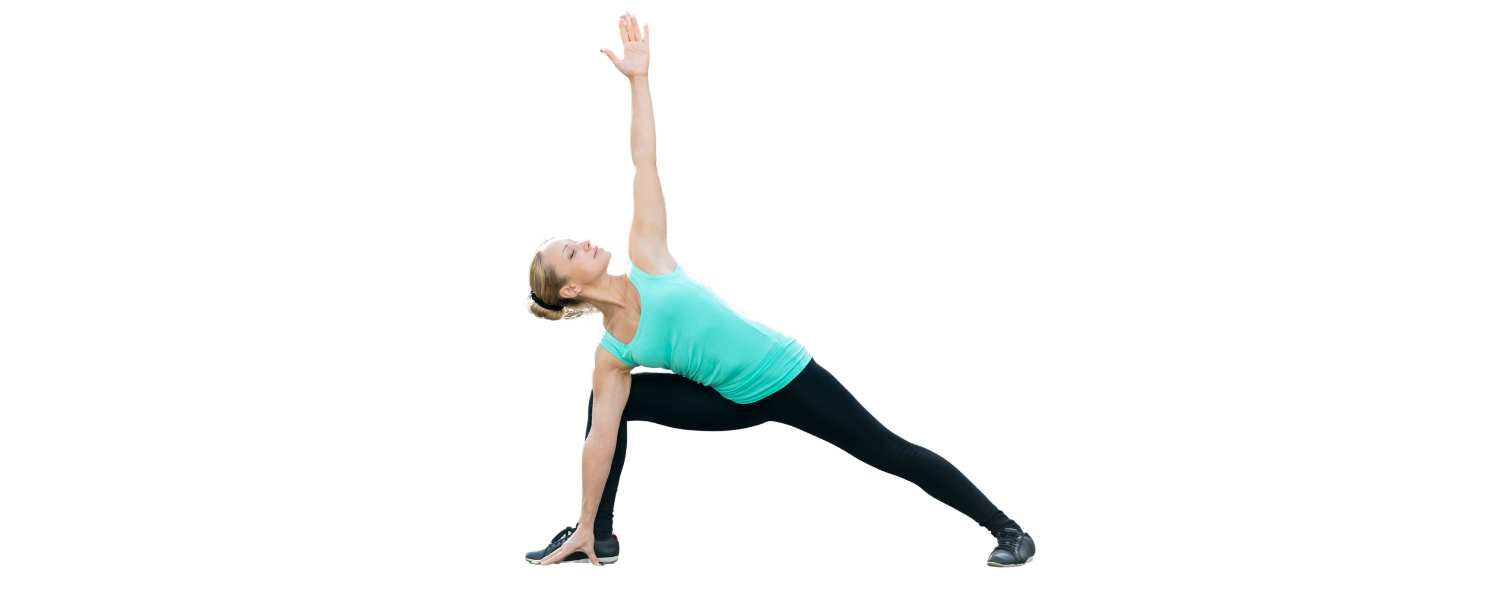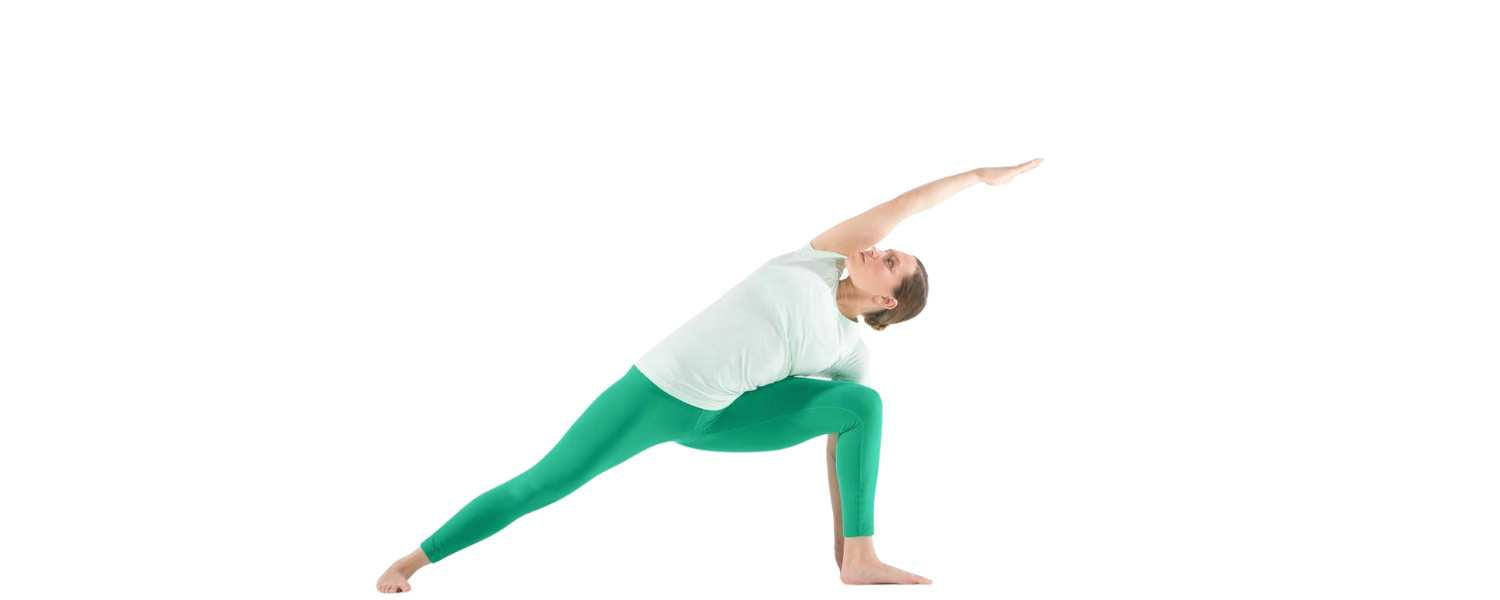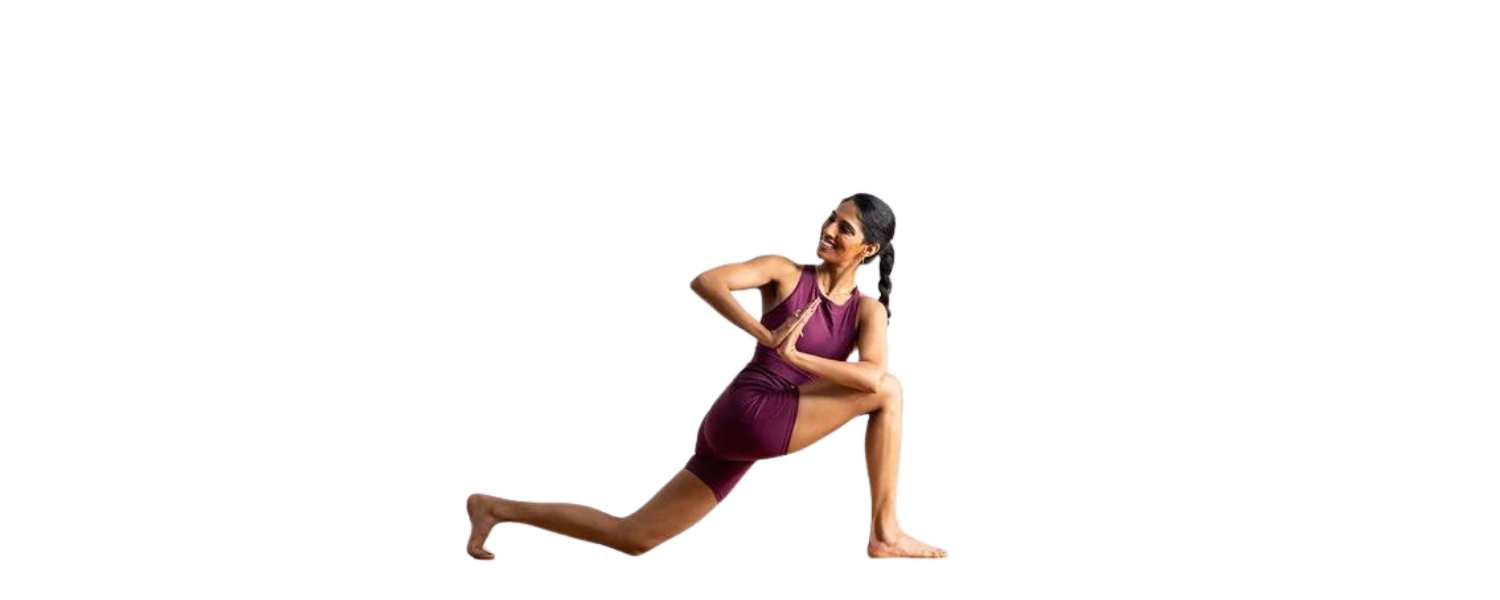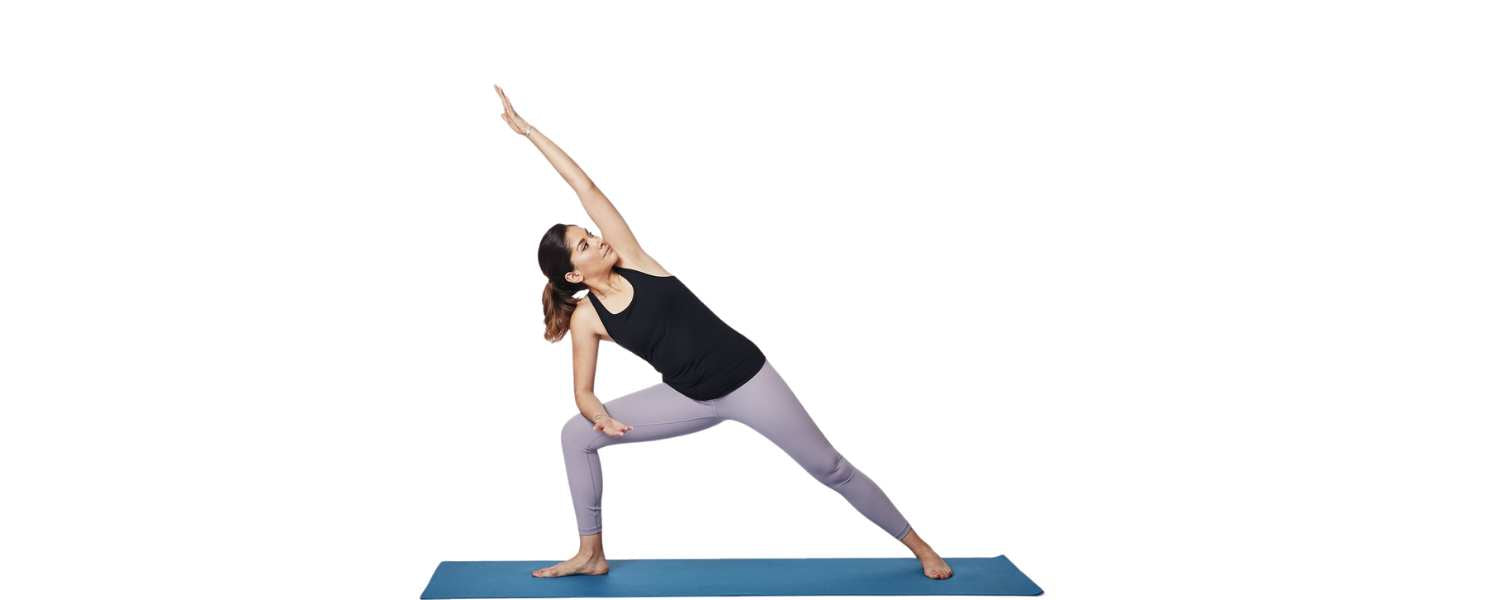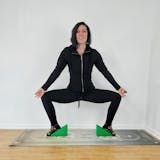Extended Side Angle Pose, known asUtthita Parsvakonasana in Sanskrit, is a fundamental yoga posture that offers numerous benefits for both the body and the mind.
As astanding balance pose, it engages the lower body while promoting stability and focus. In this blog, we will delve into the techniques and nuances of Extended Side Angle Pose, exploring how to deepen your practice and reap its numerous rewards.
Pose Type: Standing Balance
Extended Side Angle Pose is a standing balance pose in yoga. These poses typically require strength, flexibility, and concentration as they challenge one's ability to maintain equilibrium while standing on one leg or in a stable position.
Targets: Lower Body
One of the primary areas targeted by the Extended Side Angle Pose is thelower body, which encompasses the muscles of the legs, groin, and hips. By engaging these muscle groups, the pose helps to build strength, improve flexibility, and increase overall stability in the lower body.
Why we love this pose
We love Extended Side Angle Pose for a multitude of reasons:
1. It offers a deep stretch to various body parts, including the side body, groin, and inner thigh, promoting flexibility and mobility.
2. It simultaneously strengthens muscles in the legs, hips, and core, helping to build stability and support.
3. The pose encourages mindfulness and focus as practitioners must maintain balance and alignment, fostering a deeper connection between the body and the mind.
Teacher tips
As a yoga teacher guiding students through Extended Side Angle Pose, there are several essential tips to keep in mind:
1. Emphasize Alignment
Encourage students to focus on proper alignment throughout the pose. This includes aligning the front knee directly over the ankle, keeping the torso open and extended, and reaching through the fingertips to create length in the side body.
2. Breath Awareness
Remind students to maintain steady and rhythmic breathing throughout the pose. Encourage them to deepen their breath and use it to facilitate the stretch and maintain stability.
3. Offer Variations
Provide modifications and variations to accommodate students of all levels. Offer options such as using a block for support, bending the front knee less intensely, or exploring different arm positions to tailor the pose to individual needs.
4.Core Engagement
Emphasize the importance of engaging the core muscles to support the body in the pose. Encourage students to draw the navel towards the spine and actively engage the abdominal muscles to create stability and control.
5. Mindful Transitioning
Guide students through mindful transitions into and out of the pose. Encourage them to move slowly and with intention, maintaining awareness of their breath and body throughout the process.
6. Encourage Exploration
Invite students to explore the pose with curiosity and openness. Encourage them to notice any sensations or areas of tension in the body and to adjust the pose accordingly to find greater comfort and ease.
7. Provide Positive Feedback
Offer positive reinforcement and encouragement to students as they explore Extended Side Angle Pose. Acknowledge their efforts and progress, and celebrate any improvements they make in their practice.
Beginner’s tips
For beginners approaching Extended Side Angle Pose, here are some essential tips to help ease into the posture:
1. Start Slowly
Begin by practicing the pose with patience and gentleness. It's okay if you don't achieve the full expression of the posture right away. Focus on gradually building strength and flexibility over time.
2. Use Props
Utilize props such as yoga blocks or a chair to support your body in the pose. Placing a block under the bottom hand can provide added stability and make it easier to maintain balance. Don't hesitate to use props to make the pose more accessible and comfortable.
3. Focus on Alignment
Pay close attention to your alignment in the Extended Side Angle Pose. Keep the front knee aligned over the ankle, and avoid letting it collapse inward. Keep the chest open and the spine elongated to create space and length in the pose.
4. Breathe Deeply
Remember to breathe deeply and steadily throughout the pose. Focus on inhaling deeply to expand the chest and create space in the body, as well as exhaling fully to release any tension or tightness. Use your breath to help you relax and find ease in the pose.
5. Modify as Needed
Don't be afraid to modify the pose to suit your body's needs. If you feel tight or uncomfortable, bend the front knee less profoundly or use a higher block for support. Listen to your body and adjust as needed to ensure you feel safe and comfortable in the pose.
6. Practice Regularly
Like any yoga pose, consistent practice improves the Extended Side Angle Pose. Make it a regular part of your yoga routine, and you'll gradually notice improvements in your strength, flexibility, and overall comfort in the pose.
Modifications and Variations
Extended Side Angle Pose offers a range of modifications and variations to suit practitioners of all levels. Here are some options to consider:
Modifications
1. Use a Block
Place a block under the bottom hand for added support if reaching the floor is challenging. This can assist in preserving correct alignment and alleviating strain.
2. Bend the Front Knee Less
To lessen the intensity of the stretch in the hips and thighs, maintain a slight bend in the front knee, keeping it less than 90 degrees, rather than deeply bending it.
3. Use a Wall
Practitioners can perform the pose with their back against a wall for added support and stability, especially if balance is a concern.
4. Focus on Upper Body
If lower body flexibility is limited, focus on the upper body alignment and the stretch along the side of the body while keeping the legs more comfortable.
Variations
1. Bound Extended Side Angle Pose
This variation involves binding the top arm behind the back, reaching for the opposite thigh, or binding the hands together. This adds a shoulder and chest opening component to the pose.
2. Revolved Extended Side Angle Pose
In this variation, the torso rotates towards the sky, stacking the shoulders and extending the top arm upwards. This deepens the twist and challenges balance and core stability.
3. Extended Side Angle Pose with a Bind
For advanced practitioners, adding a bind (clasping hands together) underneath the front thigh can deepen the stretch in the shoulders, chest, and hips.
4. Half-Bound Extended Side Angle Pose
Instead of a full bind, practitioners can opt for a half-bind by placing the top hand on the hip or reaching it towards the sky while the bottom hand remains on the floor or a block.
5. Extended Side Angle Pose with a Prop
Use a strap to connect the hands if reaching the hands together is not accessible. This allows practitioners to experience a similar stretch without straining the shoulders or back.
Step-by-Step Instructions
Here's a step-by-step guide to performing the Extended Side Angle Pose (Utthita Parsvakonasana):
1. Starting Position
Begin standing in Mountain Pose (Tadasana) at the top of your mat, with your feet together and arms at your sides. Take a moment to ground down through your feet and lengthen through your spine.
2. Step Back
Take a wide step back with your right foot, approximately 3-4 feet from your left. Turn right foot out 90 degrees so your toes point toward the short edge of your mat. Keep your left foot facing forward.
3. Extend Arms
Extend your arms to the sides at shoulder height, parallel to the floor. Your palms should be facing down, your fingertips active, and you should reach away from each other.
4. Bend Front Knee
Bend your left knee, stacking it directly over your left ankle. Ensure your knee points in the same direction as your toes, not collapsing inward.
5. Lower Hand
Lower your left hand to the outside of your left foot. You can place it on a block for support or directly on the floor if your flexibility allows. Your hand should be in line with your left foot.
6. Extend Top Arm
Reach your right arm towards the sky, extending through your fingertips in the yoga pose thread the needle. Your right arm should align with your right ear, creating a straight line from your fingertips to your foot.
7. Open Chest
Keep your chest open and lifted, rolling your right shoulder back. Activate your core muscles to provide support for your spine and ensure stability.
8. Lengthen Spine
Lengthen through your spine, creating space between each vertebra. Avoid collapsing into the pose; instead, imagine reaching energy through the crown of your head and out through your fingertips.
9. Gaze Direction
Turn your gaze upward towards your right hand, if comfortable for your neck, or look straight ahead or down towards the floor for a more neutral neck position.
10. Hold and Breathe
Maintain the pose for a few breath cycles, ensuring your breaths are deep and steady. Feel the stretch along the left side of your body, from your fingertips down to your left foot. Allow your breath to facilitate the stretch and deepen your experience in the pose.
11. Release and Repeat
To come out of the pose, softly straighten your left leg and lower your right arm back down to your side. Transition back to Mountain Pose by stepping your feet together, and then repeat the sequence on the opposite side.
Safety and Precautions
Yoga, including the Extended Side Angle Pose, offers numerous bodily and mental benefits. However, it's essential to approach any yoga pose with mindfulness and awareness of your body's limitations to prevent injury and ensure a safe practice. Here are some safety tips and precautions to keep in mind when practicing Extended Side Angle Pose:
1. Listen to Your Body
Pay attention to how your body feels during the pose. If you experience any sharp or intense pain, back off immediately. Yoga should never be painful, so honor your body's signals and adjust the pose as needed. Remember to choose comfortable leggings green that allow for ease of movement during your practice.
2. Avoid Overexertion
While it's essential to challenge yourself in your yoga practice, avoid pushing your body beyond its limits. Respect your current level of flexibility and strength, and gradually work towards deeper expressions of the pose over time.
3. Modify as Needed
Don't hesitate to use props such as blocks or a chair to support your body in Extended Side Angle Pose, especially if you're working on improving flexibility or recovering from an injury. Modifying the pose can help maintain proper alignment and prevent strain.
4. Protect Your Knees
Be mindful of the alignment of your front knee in Extended Side Angle Pose. Ensure that it stays directly over your ankle and doesn't collapse inward. This helps protect your knee joint from unnecessary stress and strain.
5. Engage Your Core
Activate your core muscles throughout the pose to bolster your spine and uphold steadiness. This can help prevent excessive arching in the lower back and protect against strain.
6. Breathe Deeply
Focus on deep, steady breathing throughout the pose to help calm the mind and facilitate the stretch. Avoid holding breath or taking shallow breaths, as this may lead to heightened tension throughout the body.
7. Be Mindful of your Neck
If you experience discomfort or strain in your neck, adjust your gaze to a more comfortable position. Instead of turning your gaze upward, look straight ahead or down towards the floor.
Conclusion
Extended Side Angle Pose is a powerful yoga positions for core strength, stretches, and balances the body and mind. By incorporating this pose into your practice regularly and exploring its variations and modifications, you can enhance your knowledge of yoga and access higher levels of strength, flexibility, and mindfulness.
Remember to approach the pose with patience, awareness, and respect for your body's limitations, and enjoy the journey of exploration and self-discovery it offers.
Green Apple Activewear provides supportive and breathable clothing options that enhance comfort and mobility during Extended Side Angle Pose. Their moisture-wicking fabrics keep you dry and cool, while the flexible design allows for unrestricted movement, aiding in achieving proper alignment and deepening the stretch.
With their eco-friendly materials, Green Apple Activewear aligns with the principles of yoga, promoting sustainability and mindfulness both on and off the mat. By wearing Green Apple Activewear, practitioners can feel confident and supported as they explore the nuances of Extended Side Angle Pose, focusing on their practice without distraction.


